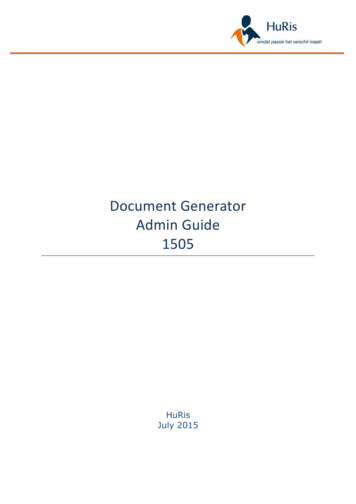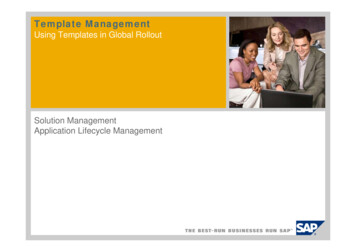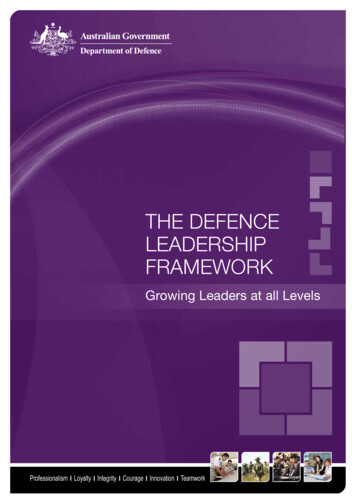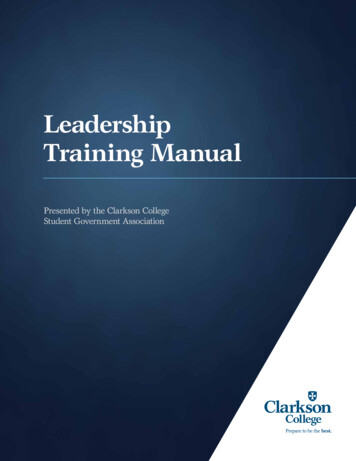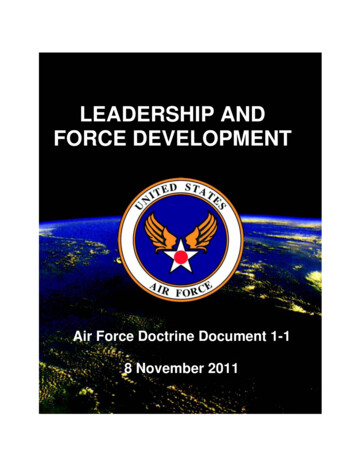
Transcription
LEADERSHIPANDAFDD Template GuideFORCE DEVELOPMENTAir Force1-120 DoctrineSeptemberDocument2002.8 November2011
BY ORDER OF THEAIR FORCE DOCTRINE DOCUMENT 1-1SECRETARY OF THE AIR FORCE8 NOVEMBER 2011SUMMARY OF CHANGESThis document is substantially revised and must be completely reviewed.Thestructure of the document has been changed to present information in a more cohesivemanner, reducing the number of chapters from four to three. The discussion on themeaning of the term ―Airman‖ has been completely revised (Chapter 1). The discussionon leadership has been expanded to include a historical review of leadership doctrinefor the Air Force (Chapter 2). Enduring competencies have been replaced byinstitutional competencies (Chapter 3 and Appendix C). A new appendix has beenadded: The Institutional Competency List (Appendix C). The appendix containing casestudies has been renamed ―leadership studies‖ to more accurately reflect the contents,and new studies have been added (Appendix E).Supersedes: AFDD 1-1, 18 Feb 06OPR: LeMay Center/DDSCertified by: LeMay Center/CC (Maj Gen David S. Fadok)Pages: 92Accessibility: Available on the e-publishing website at www.e-publishing.af.mil for downloadingReleasability: There are no releasability restrictions on this publicationApproved by: NORTON A. SCHWARTZ, General, USAFChief of Staff
FOREWORDThe Air Force develops leaders. Leadership is a skill that we learn, develop, andpractice; it is not necessarily inherited nor ingrained in our DNA. This doctrinedocument presents the Air Force‘s best practices for creating leaders and applyingleadership.Leaders do not abruptly appear fully developed and ready to perform. A growthperiod must occur to allow young leaders time to mature into the responsibilitiesrequired of senior institutional leaders and commanders. The force developmentprocess provides the means to develop leadership. Our Air Force requires leaders whocan take warfighting to the highest possible level of success in support of our nationalsecurity objectives. Those leaders are created through a process of developmentinvolving education, training, and experience coupled with ongoing mentoring by moreexperienced leaders. The end result is the development of Airmen capable of excellingas leaders at all levels, anywhere, anytime.The Air Force core values are the bedrock of leadership. Integrity First is thebasis of trust, and trust is the vital bond that unifies leaders with their followers andcommanders with their units. Trust makes leaders effective, and integrity underpinstrust. Service Before Self is the essence of our commitment to the nation. Leaders whoserve selflessly inspire support from everyone in their command and promote a spiritthat binds organizations into an effective warfighting team. Excellence in All We Do isour commitment to the highest standards of service to our country. Leaders set thestandard for excellence in their organizations.This document is the Air Force statement of leadership principles. Your personalleadership is the key to our Service‘s success in fulfilling our mission to fly, fight, andwin.NORTON A. SCHWARTZGeneral,General, USAFUSAFChiefChief ofof StaffStaff
TABLE OF CONTENTSPREFACE .ivCHAPTER ONE—The Airman . 1The Airman‘s Perspective . 2The Total Force . 3The Air Force Core Values . 9Integrity First . 10Service Before Self . 12Excellence in All We Do . 13Warfighting and the Profession of Arms . 15Valor. 18Courage . 19Sacrifice . 20The Airman‘s Creed . 21CHAPTER TWO—Leading Airmen . 22Foundations of Air Force Leadership . 23Levels of Air Force Leadership . 27Tactical Expertise . 28Operational Competence . 29Strategic Vision . 31Leadership Components. 34Institutional Competencies . 34Leadership Actions. 35CHAPTER THREE—Force Development . 37Force Development Construct . 37The Continuum of Learning . 39Institutional Competencies. 40Institutional Competency Proficiency Levels . 41Institutional Competency Assessment Strategy . 43Common Guiding Principles . 43CONCLUSION . 47REFERENCES . 48APPENDIX A. The Oaths of Office and Enlistment . 49APPENDIX B. Code of Conduct for Members of the Armed Forces of theUnited States . 51APPENDIX C. Institutional Competency List . 53APPENDIX D. Education and Training . 61APPENDIX E. Leadership Studies . 66GLOSSARY . 85iii
PREFACEAir Force Doctrine Document (AFDD) 1-1, Leadership and Force Development,is the Air Force‘s capstone doctrinal publication on leadership and how the Service usesforce development to build leaders. AFDD 1-1 is a direct descendant in a line of AirForce documents chronicling leadership for the Service dating back to its earliest days.It presents the best practices of how an Airman leads and why leadership for an Airmandiffers from those of other Services. The three chapters and the appendices describewhat an Airman is, how Airmen lead, what force development is, and how it is put intopractice. Chapter 1, The Airman, explains what an Airman is and how the Airman‘sperspective is integral to his or her thinking. It gives an overview of the total force,explaining the differences in leadership by officers, enlisted members, andDepartment of the Air Force civilians, along with a description of the specializedleadership needs and limitations when dealing with contractors. It provides theauthoritative source for the Air Force core values, along with the supportingcharacteristics of valor, courage, and sacrifice that are fundamental to what anAirman is. It describes the mindset an Airman needs to conduct warfighting and howthe profession of arms is key to what an Airman does. The Airman‘s Creed islocated in this chapter to show its relationship to both the concept of what an Airmanis and how this creed is vital to leadership in the Air Force. Chapter 2, Leading Airmen, defines leadership for the Air Force. It discusses thefoundations of leadership for the Service, with a historical analysis of the origins ofleadership in the Air Force. It introduces the levels of leadership used in the AirForce for force development: tactical expertise, operational competence, andstrategic vision. This expands the discussion of levels of leadership from theprevious edition to provide greater fidelity to the concepts, along with moredescriptive terminology that is more representative of how leadership is executed. Itdescribes institutional competencies and leadership actions, and how theseleadership components are key to developing leaders. Chapter 3, Force Development, defines the term force development for the AirForce. It describes the force development construct and the continuum of learningwith its three elements of education, training, and experience. The corporate bodyfor ensuring there is a deliberate process employed in developing the workforce isexplained. Institutional competencies and how they are used to identify desiredexpectations for the total workforce are clarified. The institutional competencyassessment strategy illustrates how graduates are surveyed to determine how wellthe military education and training schools have taught them to perform theinstitutional competency descriptive behaviors at the prescribed proficiency levels.Common guiding principles demonstrate how education, training, and experienceaffect the development of Airmen.iv
The appendices provide supporting material for the discussion of leadership andforce development. The oaths of office and enlistment provide a source ofleadership for the Air Force. The code of conduct for members of the Armed Forcesof the United States grounds all members of the Armed Forces with the samerequirements of conduct. The institutional competency list is the definitive listing ofthe Air Force‘s institutional competencies and their subcompetencies, along withtheir definitions. The discussion of education and training is provided to differentiatebetween these concepts so they can be better understood in the context of forcedevelopment. The leadership studies provide real-world examples of the three levelsof leadership practiced by Airmen.The principal audience for this AFDD is all Airmen in the US Air Force. Todifferentiate US Air Force Airmen from other individuals in other Services and othernations who support airpower, the term Airman is reserved for US Air Force personneland airman is used for those from other Services and nations.As the capstone document on leadership, its application crosses all lines of rank,component, or status. This is the defining document for leadership in the US Air Force,using force development as its means of building leaders.v
CHAPTER ONETHE AIRMANToday, we have more than 39,000 Airmendeployed to 260 locations across the globe, as anadditional130,000 Airmensupportcombatantcommand operations from their home stations. Whileour operations tempo is high, you, our Nation's Airmen,continue to set the standard for excellence. We arecontinuously reminded of the courage, commitment,and sacrifice you offer on a daily basis.—Michael B. Donley,Secretary of the Air Force (SECAF),Memorial Day 2010All Airmen, military and civilian, support and defend the Constitution ofthe United States and live by the Air Force core values. Airmen are the foundationof the Air Force organizations and units that enable the Department of Defense tosupport the National Security Strategy. The term Airman has historically beenassociated with uniformed members of the US Air Force (officer or enlisted; regular,Reserve, or Guard) regardless of rank, component, or specialty.1 Today, Department ofthe Air Force (DAF) civilians are incorporated within the broader meaning of the termwhen there is a need to communicate to a larger audience within the Service, either forforce development purposes or for clarity and inclusiveness by senior leaders whenaddressing a larger body of personnel.Airmen recognize and value airpower in its application, which is fundamentallydifferent and more flexible than other forms of military power and instruments of nationalpower.2 This inherent flexibility allows our force to be applied independently or inconcert with other forms of military power. The application and integration of airpowerproduce effects across multiple domains and theaters. Air Force forces are employedat different speeds and closure rates and over greater distances and should be appliedby those who appreciate the breadth and scope of that power across the range of1This broader meaning does not, however, mean or imply that anyone other than uniformed members ofthe US Air Force are members of the armed Services in other contexts. For example, in the context ofpunitive Air Force instructions or the law of armed conflict regulations, care must be taken to ensure thatthe rights and obligations imposed under those regulations are not uniformly applied to both Servicemembers and civilians.2See AFDD 1, Air Force Basic Doctrine, Organization, and Command, for a discussion on the Air Force‘sroles, missions, and Service core functions.1
military operations as unique.Due to thedistinctive nature of the capabilities brought tothe fight, Airmen see their Service as unique.3The study of airpower and the strengthsof its capabilities lead to a particular expertiseand a distinctive point of view that GeneralHenry H. ―Hap‖ Arnold termed ―airmindedness.‖4The Airman‘s perspective is forged fromhorizonless operations from, in, and through theair, space, and cyberspace domains.5 Whereasland and maritime domains each comprise aportion of the earth‘s surface, air, space surround 100% of our world.The Airman‘s perspectivemay be shared by members ofthe other Services and othernations who apply airpower.To differentiate US Air ForceAirmen from these other likeminded individuals, the termAirman is reserved for US AirForce personnel while airmanis used as a general term forthose from various Servicesand nations.THE AIRMAN’S PERSPECTIVEThe US Air Force flies, fights, and wins in air, space, and cyberspace. TheAir Force provides organized, trained, and equipped forces to support combatantcommanders who are responsible for deterring attacks against the United States, itsterritories, possessions, and bases, and employing appropriate force should deterrencefail.6 Air, space, and cyberspace are flexible and dynamic domains that presentopportunities and vulnerabilities. These vulnerabilities, when not mitigated, may beused by America‘s adversaries to their advantage. The Air Force is the premierAmerican military force capable of overcoming those vulnerabilities in defense of theUnited States.Airmen are essential to the successful execution of the Air Force‘sresponsibilities in support of the combatant commanders, therefore they shouldunderstand and actively advocate the Airman‘s perspective on the use of airpower toachieve national objectives. Understanding the Airman‘s perspective gives Airmen adistinct advantage when performing the responsibilities of the Air Force. They approachmission accomplishment in a manner unique to those educated, trained, andexperienced in bringing an airmindedness to all actions they perform. Airmen bring aperspective to performing the Air Force‘s mission that compounds their effectiveness ina manner best suited to support the Air Force, joint, and multinational fight.Airmen normally think of airpower and the application of force from a functionalrather than geographical perspective. Airmen do not divide up the battlefield into3Maj Gen Charles Dunlap, Jr., Understanding Airmen: A Primer for Soldiers, Military Review,September-October 2007, 126.4Gen Henry H. (―Hap‖) Arnold, Third Report of the Commanding General of the Army Air Forces to theSecretary of War, Baltimore, Md: Schneidereith, 12 November 1945, 70.5Air Force Manual 1-1 (1992), Essay U: Airmindedness: An Example.6Unified Command Plan, paragraph 10.a.2
operating areas.7 Airmen typically approach battle in terms of creating effects to meetjoint force commander objectives, rather than on the nature and location of specifictargets.8 This approach normally leads to more inclusive and comprehensiveperspectives that favor holistic solutions over tactical ones.When Air Force forces are employed in various operational environments, theyoffer basic characteristics that, when exploited, are fundamental to the successfulconduct of war and peace. These characteristics, when molded into viable forcecapabilities and executed by knowledgeable Airmen, enhance the overall ability of thejoint force to achieve success when called upon. Therefore, each Airman shouldunderstand and be able to articulate the full potential and application of Air Forcecapabilities required to support the joint force and meet the nation‘s securityrequirements.THE TOTAL FORCEThe total force consists of the people who make up the Air Force. It is defined as―the US Air Force organizations, units, and individuals that provide the capabilities tosupport the Department of Defense in implementing the national security strategy. Totalforce includes Regular Air Force, Air National Guard of the United States, Air ForceReserve military personnel, US Air Force military retired members, US Air Force civilianpersonnel (including foreign national direct and indirect-hire, as well as nonappropriated fund employees), contractor staff, and host-nation support personnel.‖9The regular Air Force is defined as the component of the Air Force thatconsists of persons whose continuous service on active duty in both peace and war iscontemplated by law, and of retired members of the regular Air Force.10 The Air NationalGuard is an organized state militia and a reserve component of the Air Force. The AirNational Guard of the United States is a federal organization that is also a reservecomponent of the US Air Force. Air National Guard Airmen serve in both organizations,and can move between them as duty requires.11 The Air Force Reserve is a componentof the United States Air Force as prescribed by law. 12 They are represented by a mix ofTraditional Reservists, Individual Mobilization Augmentees, participating IndividualReady Reservists, Air Reserve Technicians, Title 32 Excepted Civil Service Technicians(Guard Technicians), and Active Guard/Reserve, both Drill Status Guardsmen and fulltime forces.7Col Dennis M. Drew, Joint Operations: The World Looks Different from 10,000 Feet, Airpower Journal,Fall 1988, pj/apj88/fal88/drew.html, accessed 6 Jan 09.8Air Force Doctrine Document (AFDD) 1, Air Force Basic Doctrine, Organization, and Command; AFDD3-60, Targeting.9AFI 90-1001, Responsibilities for Total Force Integration, 29 May 07 (IC 1, 25 Apr 08).10Title 10, United States Code (U.S.C.) §8075.1110 U.S.C. §101(c)(4) and (5); Perpich v. Department of Defense, 496 U.S. 334, 110 S. Ct. 2418, 110L.Ed.2d 312 (1990).1210 U.S.C. §10101. In addition, non-participating and inactive members who are part of the IndividualReady Reserve, the Standby Reserve, and the Retired Reserve are subject to recall as authorized bylaw. See 10 U.S.C. §§ 10144, 10151, and 10154.3
DAF civilians are members of the total force, but are not members of the aboveelements of the Air Force. Regular Air Force, Guard, Reserve, and DAF civilians fallunder the use of the term Airman when force development issues are discussed orgeneral inclusiveness by senior leaders is required for clarity in communication.Air Force contractors are also members of the total force, but their connection tothe Service does not rise to the same level as that of regular Air Force, Guard, Reserve,or DAF civilians, who are required to swear an oath of allegiance. Contractors supportthe missions of Airmen. Managing contractors requires a different leadership approachbecause they are not part of the military chain of command. Contractor personnelshould be managed through the terms and conditions set forth in their contract. Theydo not normally fall under Uniform Code of Military Justice authority. Therefore, it isimperative that Air Force leaders ensure a strong contractor management system is inplace in both peacetime and during contingency operations.Upon entering the Service, Air Force officers, enlisted members, and DAFcivilians take an oath,13 signifying their personal commitment to support and defend theConstitution of the United States and a commitment and willingness to serve theircountry for the duration of their Air Force careers. The oath is a solemn promise to doone's duty and meet one's responsibilities. The oath of office for officers and civiliansand the oath of enlistment for enlisted personnel are in Appendix A.Officers14A military officer has responsibilities as aYou were chosen towarfighter, a servant of the Nation, a member ofbeanofficer because youthe profession of arms, and a leader ofhave the potential qualities ofcharacter. Frequently, these roles are carrieda leader, just as an athlete isout simultaneously.While officers often―signed‖ by a big leagueshoulderourAirForce‘sleadershipteam and the aviation cadetresponsibilities, that leadership role must beis selected for flying trainingearned through demonstrated adherence to ourbecause they have certaincore values and proven followership abilities.innate abilities.One must be a good follower in order to be agood leader. Preparation to fulfill the role of an—Air Force Manual (AFM)Air Force officer is a continual developmental35-15, Air Force Leadershipprocess. Air Force officers are raised with an(1948)Airman‘s perspective and grown in the cultureof the Service. This perspective is developedthrough education in how the Air Force operatesand honed through operational experience.Leadership opportunities grow throughout this developmental process as does anofficer‘s ability to articulate the capabilities the Air Force brings to the joint fight.135 U.S.C. §3331, 10 U.S.C. §502.For a thorough analysis of officership in the United States military, see The Armed Forces Officer,National Defense University Press, 2007.144
Thefunctionofcommand requires continuousalertness and willingness toaccept changed conditions.Our commanders must exertsuperior leadership; they areexpectedtoknowandinfluence their soldiers. Exertyour leadership—see that yoursoldiers ‗think straight.‘ Youwon‘t have all the answers, butyou can at least tell yoursoldiers that.—General H.H. “Hap”Arnold, from Army Air ForceLetter 35-280,19 September 1945Within the Air Force, only an officer cancommand Air Force forces.15 Command isdefined as ―[t]he authority that a commander inthe armed forces lawfully exercises oversubordinates by virtue of rank or ility for effectively using availableresources and for planning the employment gmilitaryforcesfortheaccomplishment of assigned missions. It alsoincludes responsibility for health, welfare,morale, and discipline of assigned personnel.‖16To command, an officer is educated in theAirman‘s perspective and trained in Air Forcecapabilities.This training and perspective,combined with years of experience, produce anindividual able to accept the responsibility ofsending Airmen into harm‘s way, the solepurview of a commander.Federal law states that commanders in theAir Force are required to be good examples of virtue, honor, patriotism, andsubordination; to be vigilant in ―inspecting the conduct of all persons who are placedunder their command;‖ to guard against ―dissolute and immoral practices‖ and correctthose guilty of them; and to promote and safeguard the morale, well-being, and generalwelfare of the officers and enlisted personnel under their command.17 Such tasks aresufficiently daunting that it behooves a commander to take advantage of the expertiseavailable to him or her in an organization, informally known as a command team. Thecommand team can consist of formal and informal members critical to maintaining thegood order and discipline of an Air Force unit. The members of the command teamshould possess the experience, functional prowess, and maturity required to makedecisions of great impact to the organization, the individuals in the organization, and theAir Force. Operating together, a commander with his or her command team leads AirForce organizations in the execution of Air Force duties.Enlisted MembersCommanders depend upon NCOs to lead subordinates to accomplish the mission.—Air Force Pamphlet (AFPAM) 36-2241 (1 Jul 09), para 10.115The ultimate source for command authority is the U.S. Constitution, Article II, §2, making the Presidentthe Commander-in-Chief of the US military. For military discipline purposes, 10 U.S.C. §801 states, ―Theterm ‗commanding officer‘ includes only commissioned officers.‖16Joint Publication (JP) 1-021710 U.S.C. §8583.5
The Air Force‘s enlisted members provide the Service with the highest degree oftechnical expertise within their respective functional areas. Inherent in the oath ofenlistment (see Appendix A), enlisted members are bound to the ideal of followership.Although not commissioned and thereby notThroughout my Air Forceentitled to be in command positions, enlistedcareer,I‘ve seen how ourmembers perform leadership roles across allAirmendemonstratetheirAir Force organizational levels and are highlycommitment to serve—everyrespected members of the Air Force leadershipday, around the world.team. Education, training, and an Airman‘sperspective, combined with a wealth of—Chief Master Sergeant oftechnical expertise, sustain enlisted membersthe Air Force James A. Roy,in the leadership of other enlisted forces who2009support their unit, the unit‘s mission, and the Air18Force at large.The Air Force enlisted members are true to a professional calling thatencompasses a high degree of specialized training, Service orientation, and a distinctsubculture. Enlisted members demonstrate dedication to this calling through hard work,loyalty, and mission accomplishment regardless of hardship or adversity. Often referredto as the ―backbone‖ of the Air Force, enlisted members are grounded in the Air Forcecore values and are bound to the idea of followership. Enlisted members are alsobrought up with an Airman‘s perspective and receive professional military education andtraining tailored to appropriate levels of leadership and responsibility in accordance withAFI 36-2618, The Enlisted Force Structure; this document provides guidance anddirection for all enlisted ranks. Enlisted members are Airmen first and specialistssecond. Lastly, they carry a strong belief in setting aside their own wants and needs inseeking the greatest good for their subordinates, peers, and leaders in defense of theConstitution of the United States and the officers appointed over them.CiviliansIf it is a military requirement, then the military will do it—if not, then youdefinitely want civilians doing it.— Roger M. Blanchard,Assistant Deputy Chief of Staff for Personnel, Headquarters Air Force,1997-2007DAF civilians are indispensable to the management and operation of the Service.As civilians, they cannot exercise command authority over military members19 but do18See AFPAM 36-2241, Chapter 10, for a discussion on leadership and followership for the enlisted force.There are two exceptions to civilians being prohibited from commanding military forces: The President,as Commander-in-Chief under Article II, §2 of the US Constitution. In addition, 10 U.S.C. §113 and 50U.S.C. §401 place the military departments under the direction, authority, and control of the Secretary ofDefense.196
perform in leadership roles throughout the Service and across all organizational levels.As of 2010, the US Air Force employs over 170,000 civilians in a full range ofoccupations. Civilians often provide stability and continuity as their duties and positionswill frequently remain in an organization for long durations with the ability to supportmultiple commanders over years of service. They fill positions in staff and basesustainment operations that would otherwise be filled by military personnel. Theirleadership skills are enhanced through an education and training regimen suited fortheir growth in the functional areas in which they provide expertise.20Theirexperiences, often honed through many years in a given functional area, give them alevel of knowledge developed to an extensive degree. As stated in the Oath of Office,civilians are to understand and value the essential role of followership in missionaccomplishment.DAF civilians respond to the needs of the Air Force across the range of militaryoperations. As an example, the Civilian Expeditionary Workforce initiative is desi
Air Force Doctrine Document (AFDD) 1-1, Leadership and Force Development, is the Air Force's capstone doctrinal publication on leadership and how the Service uses force development to build leaders. AFDD 1-1 is a direct descendant in a line of Air Force documents chronicling leadership for the Service dating back to its earliest days.

